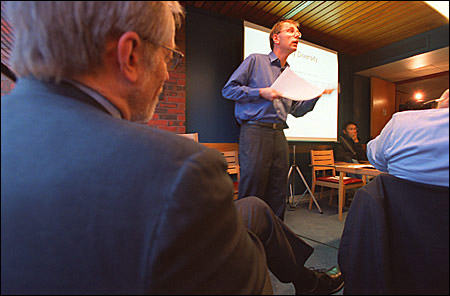KSG’s Stuart shares findings on Boston race trends
New study shows that metropolitan region is atypical

Boston is whiter than most U.S. metropolitan areas – 81 percent compared with a national average of 66 percent – and in many of the region’s suburbs, whites have little chance of encountering others different from themselves, a situation that Guy Stuart finds troubling.
“The rest of America looks very different from Boston. Whites here are very isolated. When kids go out into a bigger, wider world, they will encounter more diverse universities, a more diverse work force, and they may not have the interpersonal skills to deal with those situations.”
Stuart, an associate professor of public policy at the Kennedy School of Government, is the author of a new study, “Boston at the Crossroads: Racial Trends in the Metropolitan Region in the 1990s and Beyond.” Stuart’s research was supported by the Rappaport Institute for Greater Boston and the Taubman Center for State and Local Government. He presented his findings in a talk this past Tuesday (Dec. 14).
In his study, Stuart compares Boston with three other metropolitan areas – Atlanta, Chicago, and the San Francisco Bay Area. He finds that Boston differs from these areas in several significant ways. It is more racially segregated than the Bay Area, but less so than Chicago.
“People think there’s a highly concentrated black ghetto in Boston. There isn’t, not compared with a city like Chicago. When I was working there in community economic development, I would often get on a bus and not see another white face for miles and miles. That doesn’t happen here.”
But what Boston has that other metropolitan areas don’t is a greater number of satellite cities, containing 15 percent of the region’s population, compared with a national average of 9 percent. This ring of cities – Attleboro, Brockton, Fall River, Lawrence, Lowell, New Bedford, and Worcester – have attracted large populations of blacks, Asians, and Latinos, while whites have either moved out or consolidated in predominantly white neighborhoods.
Another factor that distinguishes Boston from the rest of the country is the diversity of its minorities. For example, 26 percent of blacks in the Boston area are foreign born (mostly Haitians and Cape Verdeans), as opposed to 6 percent for the rest of the country. Asians are an extremely heterogeneous group, which includes Chinese, Indians, Vietnamese, and Cambodians, while Dominicans and Puerto Ricans make up the bulk of the region’s Latino population.
While whites still make up a larger percentage of the population than in other U.S. regions, there are some indications of change. The overall percentage of whites in 2000 (81 percent) is down from 87 percent in 1990. Boston’s suburbs are still unusually white (90 percent as opposed to 75 percent for metro America), but the percentages of minorities moving to the suburbs are slowly increasing.
But for those who consider racial integration to be a public good, Stuart finds cause for hope. One positive sign is greater evidence of racial tolerance among whites. In surveys conducted in the region, white respondents said they would be comfortable living on a block where one in 15 households belonged to a minority.
“That doesn’t sound like a lot, but if whites are willing to walk the talk, something will happen. The key is white behavior – will they integrate or will they flee, and if so, where to?”
Stuart titled his study “Boston at the Crossroads” because he believes the region could go in either of two directions – segregation or integration. He still has hope that through such efforts as reforming fair housing practices, revitalizing urban economies, and promoting education, Boston will be able to make the right choice.
“I don’t think we’re on a slippery slope toward a separate and unequal society. We can create a multicultural, global, metropolitan region. The ‘City on the Hill’ can realize itself, but it will require concerted action.”




